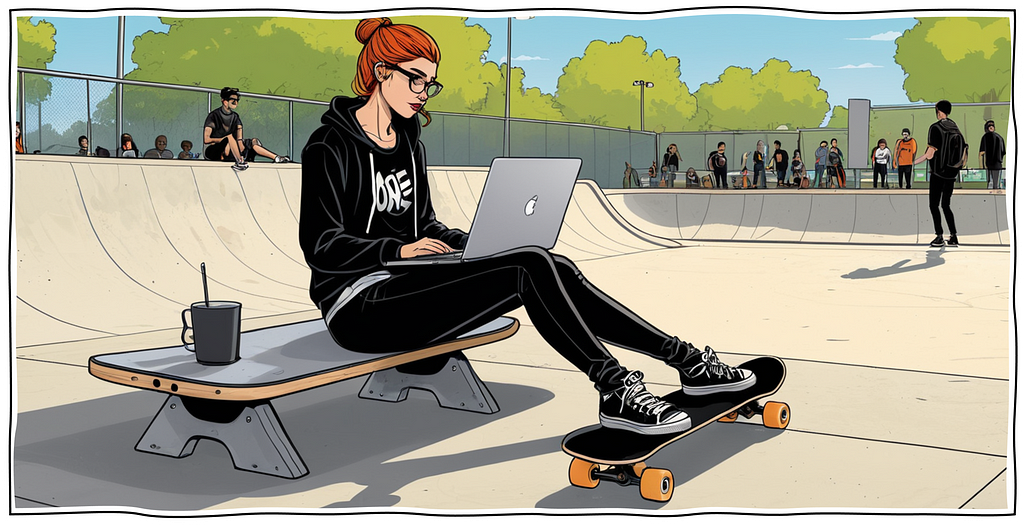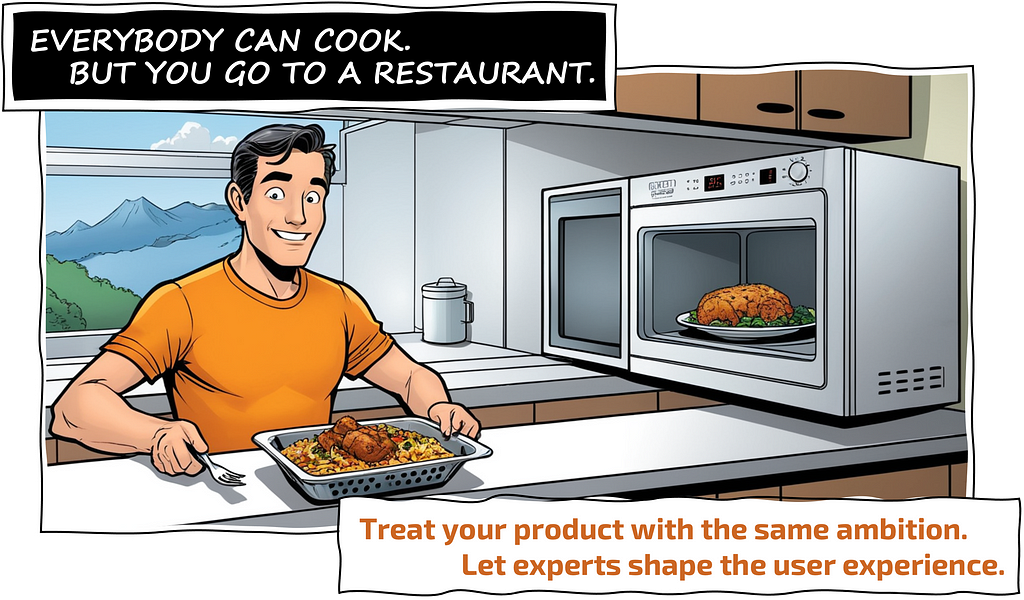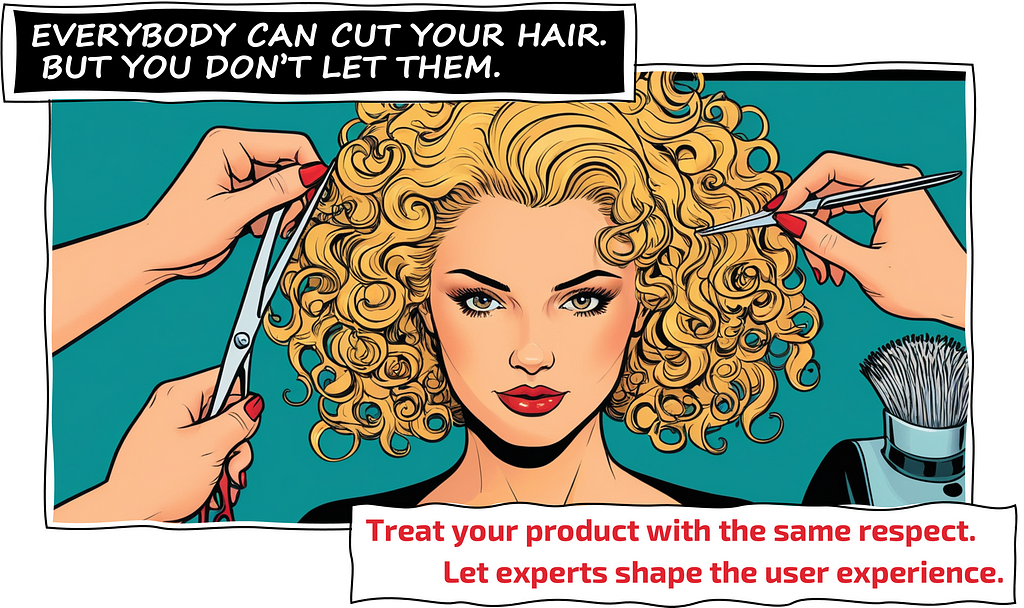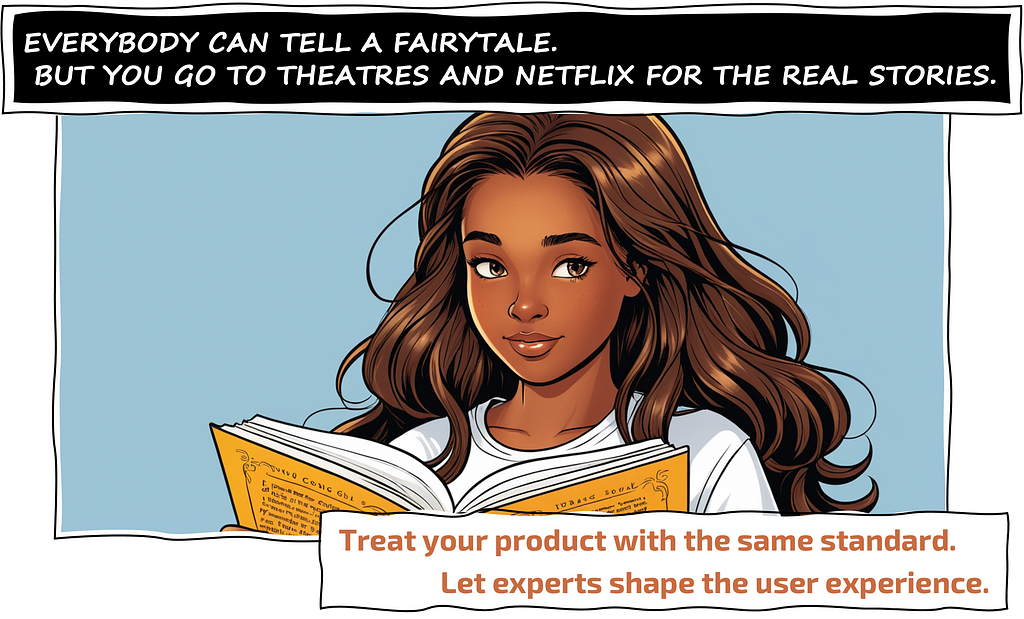5 Funny Metaphors to Explain Why it Needs UX Professionals
Let experts shape the user experience.
This article tells five little entertaining stories to explain why you need (UX) experts to design interfaces. The intended audience of those stories is all people involved in product development processes. The people who could use those metaphors are meant to be designers.

Why is UX sometimes misunderstood?
UX designers are not always in charge for creating interfaces. Recently in my personal network some examples came to my attention where people told me that interfaces of a product or software were created without proper support from (UX) designers. I also remember some past projects of myself, where designers were left of from feature developments, where the UX people were not involved in creating the concept of the interface, the wireframes, or the designs.
This harms the user experience. The effect is that interfaces, features, and solutions miss the ease of use, work worse than best practices show, integrate unusual patters that lead to user pains, and require much effort to repair them. This is measurable with user research instruments and documented in numerous studies.
And it is expensive. Depending on the progress of the project, different scenarios can happen. It can happen that the product will be so unsuccessful that the whole development is money down the drain. It can happen that bad interfaces are recognized and fixed afterwards — a study finds 96% less rework by integrated design (Rhodes, 2000), another states 40% faster development with proper usability engineering (Bossert, 2021). The time to market of teams with design understanding is 2x as fast as without design (PAGE Magazine 10.2023, page 26). The annual growth of companies with high design understanding is 10%, the growth of those without is 3 to 6% (McKinsey, The Business Value of Design, 2018). These and more metrics are widely known, e.g. 200% ROI with UX (source), 30% happier employees (source), 80% less client support (source).
There are a lot of reasons behind. Some examples why this can happen: time pressure for development, missing trust to the designers, fear of designer’s critique, unfamiliarity with designers, missing know-how about the designer’s way of work, expecting UX resource shortages, design work packages missing in the project plan, overestimating own skills, etc. In most of the cases the people are not really against design, but the constraints they are in, the circumstances developments are running, the pressure teams are under: this leads to this unfortunate situation.
The use of UX designers is not a luxury, it is a necessary duty to run successful research and development endeavors.
How to improve the UX facilitation?
The basic answer is: advocate user experience. This is hands-on, ad hoc. For doing so, for overcoming this flaw there are different possible strategies, each with its advantages and disadvantages:
Advertise UX to the people
•explaining the advantages of good UX design (e.g, better usability, sales figures, avoid developing unnecessary features)
- storytelling (e.g., working with analogies, metaphors, examples)
- convincing with business numbers (e.g., benefits through design, KPIs like ROI with UX)
- talk about the success of finished (internal) UX projects to motivate other groups that they want it
Educate people about UX
- teach the design 1×1 (e.g., user-centered design, interaction principles)
- let team members participate in design activities (e.g. research activities, with the methods design studio, design sprint)
- train team members for design methods & materials (e.g. with internal or external trainings, educations, certifications)
Soft activate UX design
- offering general help to the team respectively to the designers (e.g., user research activities, conception methods)
- offering concrete support tasks, based on what the team members do (e.g., co-creation, UX writing, concepts on a fitting detail level)
- discussing with the engineering manager who does what (e.g., scope definition, requirements definition, stakeholder involvement)
- measure the application of research and design methods (e.g., have users been involved, have designers been involved)
Hard activate UX design
- making it mandatory to allocate designers to development processes (e.g., by certain resource amounts, allocated team members)
- integration of design methods into main development processes (e.g., scoping, quality assurance)
- allocate design resources to development processes (e.g., as FTE percentage, allocated designer)
The second answer is: increasing the UX maturity of a company. This tackles the organisational structure, processes, and the mindset of people. This approach naturally is long-term focused and needs time, money, and ressources.
The content of this article is building on the first group (Advertise UX to the people), in particular storytelling by using metaphors.
Metaphors to create a deeper understanding
Metaphors explain stuff with examples from other domains. They are little happy stories to create a connection in people’s mind.
They work best with commonly known topics or everyday examples. They are meant to be entertaining, and explain with tongue-in-cheek a situation, relationships, or cause and effects. Metaphors work with a strong ‘picture’, here in this article executed with images and text. They should touch a recipient emotionally, create a mental model of the example, and transfer this model to the intended domain. People transfer their know-how from everyday examples to an expert field where they are not experts.
In the following there are five examples listed to explain to others, why UX activities should be performed by experts (UX designers, interaction designers, user researchers, usability engineers, UI designers, etc.).
Cooking
With luck your mother is a good cook. But your father? Or your sibling? Of course, everybody can put a pizza in the microwave. That serves your basic need. But don’t you want to have a nice taste experience? This needs a chef in the kitchen.

Do the same favor for your product. If you want more than microwave features, hire an expert. Let them craft the layout, the colors, the typography, and the interaction in your interface.
Playing Instruments
Remember that kid practising trumpet? Or that school band of the music class? Playing an instrument needs talent, education, and practice. That a song works in the radio, requires a good melody and good musicians.

Do not let design kids play with your development. Let experts talk to users, craft the wireframes and use that Figma. They know what to do and they await you with open arms.
Haircutting
You even send your kids to the hairdresser. And for special occasions, like a family party or your wedding you actually spend more time and money at the coiffeur.

Do the same with UX. Don’t let your features look like bad hair day. Let the user research, the information architecture, the concepts, and the designs be done by pros.
Storytelling
Did your parents read books with you? How was the last speech you heard at a wedding? You need talent, craftsmanship and practice to be a good storyteller. Be it as actor, orator, or moderator.

And your product? Do not develop products like a kid telling a joke. In the same way it needs skills, expertise, and experience to build the interaction, to find out the user needs, and to translate them into solutions.
Playing Soccer
Do you play in a senior sports team? Or with your kids on the weekend? This is fun right!? But when watching a game you look at the major leagues, not at your neighbors.

How is your product developed? Say no to features from the backyard. You want to have features ready for the big screens.
Outro
Have fun sharing the metaphors. If you have more or better ideas for other metaphors, let me know. Maybe they could be added here.
If you experience the same (design tasks done by non-designers), please share your experiences in the comments.
If have another another successful approach to integrate UX in teams and increase the UX maturity, please also share your experience in the comments.
There are good further readings about this topic, from UX Maturity to Design Capabilities in Companies.
All images copyright Jens Mühlstedt.
5 Funny Metaphors to Explain Why it needs UX Professionals was originally published in UX Planet on Medium, where people are continuing the conversation by highlighting and responding to this story.